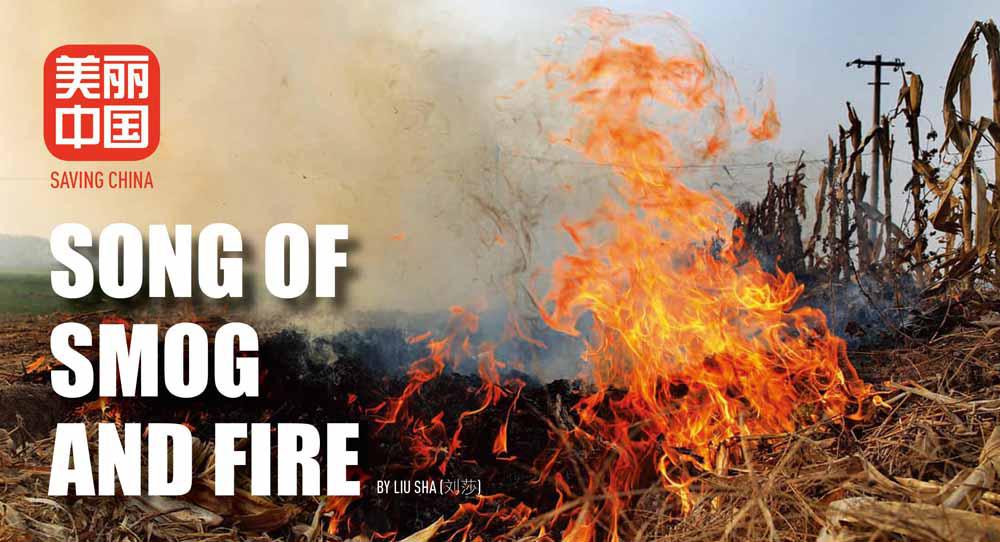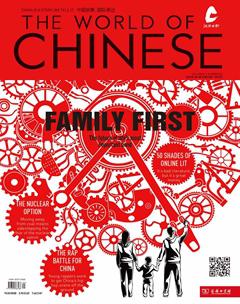SONG OF SMOG AND FIRE
刘莎

How burning straw contributes to Chinas smog problem
and whats being done about it
在霧霾笼罩的日子里,“烧秸秆”总是被千夫所指。
可是不烧又该怎么办?
The culprits for smog in North China are legion: cars, coal, gas, construction. But, in autumn and early winter, when the real smog starts to hit, people living in the city point their fingers at people burning straw in the countryside.
After grain is harvested, farmers deliberately set fire to the remaining straw and bury the ash, which acts as a natural fertilizer.
Technically, the central government banned straw burning in 1999 and local governments came out with different measures to curb the practice. But it is still common because its cheap, easy, and quick.
In recent years, with the increased sensitivity toward air quality, this local headache has taken on national significance, and people in polluted metropolitan areas have become extremely critical of the black smoke emanating from farms around the country.
People blame farmers for being irresponsible and lazy; farmers fight back by pointing out that burning straw is not a major contributor to the smog. Although both parties hold firm to their stances, some official data does show that burning straw makes the pollution problems more dire.
In early October 2015, a thick haze shrouded a large area of northern China. The Ministry of Environmental Protection (MEP) cited satellite data saying that 862 burning sites were observed from October 5 to 17, 54 more than the same period in 2014.
When expounding on the main factors causing the heavy smog, the MEP ranked straw burning as the number one contributor. China Central Television (CCTV) quoted experts saying that straw burning contributed anywhere from 14 to 55 percent of the PM2.5 density.
Soon another round of smog hit
in early November. Shenyang, the capital city of Liaoning Province, recorded the worst pollution yet—PM2.5 density readings of 1,400—on November 9, 2015. The MEPs November report said there were 702 burning sites detected in three provinces in northeastern China from November 1 to 3.
The three provinces—Heilongjiang, Jilin and Liaoning—are major grain production areas in China and are also the heaviest burning areas. Burnings are also heavy in eastern Chinas Anhui and Jiangsu provinces as well as northern Chinas Henan, Hebei, and Shandong.
Compared to the same period in 2014, the number of burning sites in 2015 increased by around 6.9 percent.
Wang Dongqing, a senior ministry official, said that slack government supervision efforts and the absence of burning control policies in some regions are reasons for the problem.
China produces about 700 to 800 million tons of straw every year. In the past, farmers would collect the straw to use as fuel, feed, and fertilizer. However, as modern agriculture developed, farmers became accustomed to chemical fertilizers and synthetic feed and village households use gas and coal. The straw simply serves no use in modern Chinese farming.
While the media and public are blaming the farmers, one farmer from Taizhou, Jiangsu Province, published a long letter online, explaining why farmers do this despite the ban, igniting a public debate on better ways to use the straw.
In the letter, he points out that a shortage of hands in the countryside is an important reason why farmers choose to burn straw rather than collect it. “We used to lay straw over the yard and make a pigsty for animals or make a small compost heap to make fertilizer, but now most young people have left the village to become migrant workers in the cities and have left few hands for such labor,” he said in the letter.
Gu Yongmin, a migrant worker in Zhengzhou, Henan Province, went back to his hometown in Xinxiang in late September 2015 to help his parents harvest corn. With a new reaping machine, the family of three only spent one week finishing the harvest. Gus parents wanted to take time to seed wheat before November, when the temperature would drop. “They hoped to finish the seeding while I was still at home and could give them a hand,” Gu told TWOC.
Before the seeding started, they had to clear the corn stalks. His parents were unsure as to whether to burn it or not, as over ten officials were dispatched to monitor the area. If they were caught, they would have to pay a 1,000 RMB fine. Last year, the elderly couple obeyed, grinding the stalks and burying them.
Burying straw and stalks can be a risky business. If its not buried deep enough, it blocks the new plants from absorbing nutrients, Gu says. “Some pests can also survive if you dont burn it.” Theoretically, to avoid such problems, they should simply follow the advice of the agriculture authorities and grind and plough twice, but that takes time. “If we just burn it all, we dont have to consider these problems.”
To persuade farmers to change from their old air-polluting practices, grassroots officials have begun taking action. Much like the farmers depending on the soil, these officials depend on keeping straw burning down in order to keep their posts. In Taikang, Henan Province, officials even guarded farmland after the harvest to ensure nothing was burned.
Taikang, a poverty-stricken town, was fined 20 million RMB in October 2015 for having too many burning sites, the China Youth Daily reported. The town government officials were summoned four times and were officially warned by Henan provincial authorities to stop burning straw.
“The large fine is a strong hit for such a poor town,” says an official surnamed Ye working at the Taikang poverty alleviation office. After being fined, Ye and his two colleagues also joined the supervision team. “We can guard the areas in the daytime but they just set fires in the middle of the night.”
Jiang Yuanwang, a farmer in Taikang, was held in detention for 14 days after being caught burning straw in October, CCTV reported. Jiang later admitted during a TV interview that he understood why it was necessary to ban straw burning, but he also said that the alternatives cost both time and money.
To grind the chaff and straw, most households do not have a stripping machine and must rent one, as well as a driver, for 70 RMB per mu (roughly 666 square meters). But under national policy, every household receives only 20 RMB in subsidies for every mu of land.
Another alternative is to collect the straw and stack it for transportation to paper mills, livestock farms, plants, or bio-gas facilities.
“The problem is that there is no place for storage and farmers will not spend their own budget for transportation,” says Xie Guanghui, professor at China Agricultural University.
The good news is that some people have started to play the role of agency, connecting individual farmers and companies that need to purchase straw.
In Minquan County, Yang Silin signed contracts with villagers, helping them to collect straw for free. Yang later sells the straw to livestock farms that feeds cows with a mixture of straw and fodder. The livestock farms save millions in feed costs.
A simple ban that forces farmers to choose less profit simply isnt working, and it increases administrative burdens, Xie says. “The government should teach and lead farmers to find business opportunities and connect them with companies in need.”

